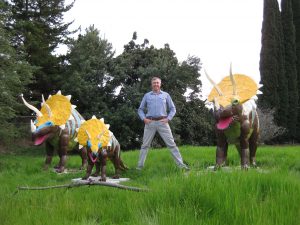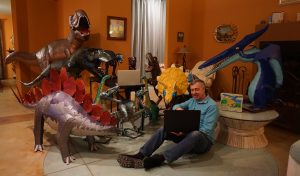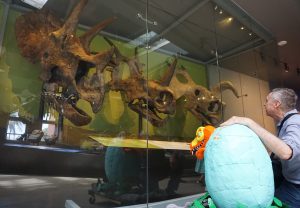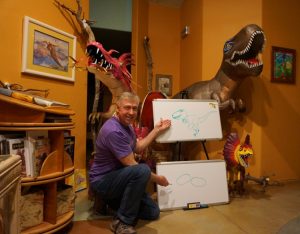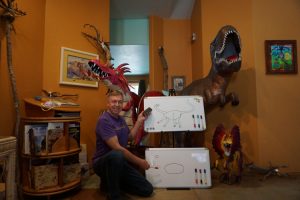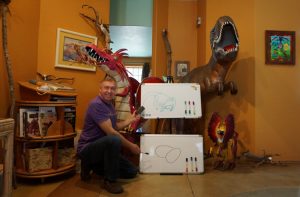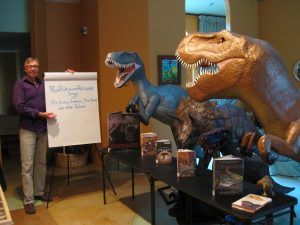Above: Teresa the Triceratops with friends Mario, Logan, Noah & Corrine.
Just when you thought you have seen the wildest head frill a new discovery is uncovered. Many times, from deep in the vast vaults of a museum’s collections. Sometimes due to original misidentification and other times from long overlooked items on the shelf. It takes years to remove fossilized bone from the rest of the rock. In the early years of collecting with only a small portion of the fossil exposed it could easily be misidentified. Many large Museums have backlogs of unopened jackets that go back more than 100 years! With new paleontologists entering the field and the flood of new discoveries, someone might see a fossil that’s been in storage for such a long time with a fresh perspective.
Nobu Tamura http://paleoexhibit.blogspot.com/ http://spinops.blogspot.com/ http://www.palaeocritti.com – Own work
Spinops sternbergorum is an example of such a discovery. Unearthed in Canada in 1916, stored away in a London Museum’s Vault to be noticed in 2004 by Andy Farke. With a Team including Paul Barrett, Darren Tanke, Michael Ryan and Mark Loewen, Farke published a paper in 2011 naming the new species. The name honors the original find by the Sternbergs and that they were right almost 100 years prior, that this was a new species closely related to Styracosaurus. Vagaceratops, Xenoceratops, Nyasasaurus, and Xenoposeidon are other examples of discoveries from specimens which sat around for many years in Museum Collections.
Vagaceratops images Canadian Museum of Nature
Xenoceratops ケラトプスユウタ – Own work Skull photo Nobu Tamura email:nobu.tamura@yahoo.com http://spinops.blogspot.com/ http://paleoexhibit.blogspot.com/ – Own work Art Restoration
The Ceratopsian Skulls are triangular, but with a wide range of horns, hooks, plates, knobs and spikes depending on the species. More than 80 species of Ceratopsians have been discovered since Triceratops. Over 50 of those since 2002. It’s also possible some of the discoveries are the same animal that has evolved to appear very differently than its ancestors. Originally it was thought that Triceratops’s horns were primarily for defense. T-Rex being their primary predator. However, it was discovered that they battled among themselves most likely for a mate. The range and variety of headgear supports the display for attracting mates, as well as defense. The Ceratopsian in Disney Pixar’s “The Good Dinosaur” known as the Pet Collector always gives me a laugh. Each of his horns provide a perch for an animal friend. The Pet Collector resembles a decorated Christmas tree with all his friends.
I have several Ceratopsian 1/35 scale models to assist me with my artwork – Triceratops, Styracosaurus, Torosaurus, Pentaceratops and Centrosaurus. Interesting that the Triceratops models from two manufacturers are significantly different in size and features. The triangular horns/plates around the shield/frill are completely lacking on the one version. As well as the snot horn much higher up.
I have changed my vision of the colors with the Triceratops at the Park. The newest color palette reflects brighter choices of modern birds and animals wishing to impress mates. A peacock tail fan provided inspiration for the Triceratops Head Frill. The other Prehistoric Pals are getting brighter colors as their turns for makeovers come up.
References: “Weird Dinosaurs” by John Pickrell and Wikipedia.org
Stay Tuned for More Dinosaur Fun Facts, Fiction & Crafts!
Consider a Membership with the Museum. In addition to Supporting Their Valuable Work there are Benefits to You. Special Preview Events for Members Only as well as Virtual Access Exclusive for Members. Below are 3 of my favorites Museums. For more information and access to general public eLearning check out the links below.
The Natural History Museum of Los Angeles County www.nhm.org under Research & Collections / Digitized Collections will allow you to browse their Collections. Check out the latest Activities on their site.
The American Natural History Museum www.amnh.org You will find eLearning for Families, Students & Educators. Explore the Museum Virtually. Check Out SciCafe: Video Talks and Meet the Icons: Stories behind the Exhibits! There are Video Series covering Behind the Scenes at the Museum with Space & Dinosaur Explainers.
Chicago’s Field Museum www.fieldmuseum.org You can talk to “Maximo the Titanosaur” online, Yes Really! Visit Sue the largest T-Rex discovered! Check Out “Brain Scoop” and the Learning Resources – many are also in Spanish.
Check Out Your Libraries eBooks. My local Library has over 900 eBooks on Dinosaurs! Here are four books for Drawing Dinosaurs that you might find at your Library. Ask your Librarian about others.
1-2-3 Draw Dinosaurs and other Prehistoric Animals A step by step guide by Freddie Levin (2001)
Draw 50 Dinosaurs and other Prehistoric Animals by Lee J. Ames (1977)
Draw it Dinosaurs by Patricia Walsh (2006)
I Can Draw Dinosaurs by Terry Longhurst (2003)
Stay Safe & Well
“Encouraging the Appreciation of Art and Education through the Inspiration of Dinosaurs”
Paul & Prehistoric Pals
Your feedback is appreciated, comment below or email:
Thank you!











